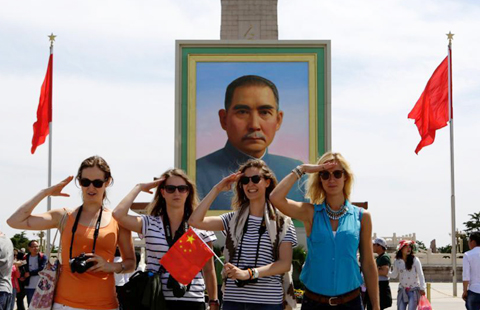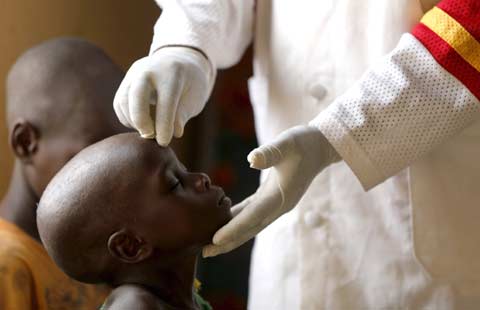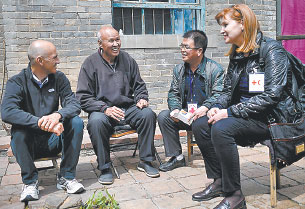Battling the scourge of MDR-TB
Updated: 2015-05-04 07:23
By China Daily(China Daily USA)
|
|||||||||
Cui Kunzhu, a 59-year-old farmer living in a remote mountain village in Yangcheng county, Shanxi province, has been going through a harrowing time during the past seven years. He has been suffering from multidrug-resistant tuberculosis since 2010, after undergoing a cancer surgery in 2008.
Like many other people suffering from similar TB-related health problems in cities such as Jincheng and Changzhi in Shanxi, Cui lives in an area where traditional farm work is the only source of income.
Cui's daughter, who is studying at a medical university, had to depend on student loans to cover her annual university expenses of 20,000 yuan ($3,230) since 2011.
To make matters worse, the family's annual disposable income of 1,000 yuan from farm work and another 2,000 yuan from government subsidy for the poor was barely enough to cover even a fraction of his daughter's university expenses.
Most of the patients like Cui in Jincheng and Changzhi live in mountainous villages.
They have been grappling with poverty and relying on government relief for sustenance for several decades. That is in sharp contrast to the rapid economic development seen elsewhere in the province, fuelled by its rich coal resources.
"At the beginning, I could not even afford the transportation costs, due to the long distance from my village to the hospital, even though the local government provided free medicines and physical examinations," said Cui.
A recent report from the Red Cross Society of China showed that TB can be cured in 85 percent of all cases, but it is essential that the procedure is completed correctly and managed in a properly manner. Improper treatment and bad living conditions have often complicated problems for patients and made their condition worse, especially the poor in rural areas.
Good nutrition and strong social support are vital for proper recovery of TB patients and the failure to do so increases risks of contracting the disease again, said Hler Gudjonsson, regional communications delegate and spokesman of the International Federation of Red Cross and Red Crescent Societies.
But the good news is that some companies and associations are now actively cooperating to combat the disease in China.
The MDR-TB Patient Aid Program, for instance, supported by Lilly Foundation and RCSC, have been working hard to help improve the conditions of 100 patients like Cui in Changzhi and Jincheng by providing necessary nutrition packages and transportation allowance.
The World Health Organization's Global Tuberculosis Report 2014 showed that TB is still one of the deadliest and most communicable diseases in the world. In 2013, an estimated 9 million people developed the disease and about 1.5 million died from it.
China continues to have one of the highest infection rates of MDR-TB, and is also home to the second-largest MDR-TB population.
Now in its third year, the program has provided aid to more than 80 patients in the first two years, 77.5 percent of whom have been cured or have seen a vast improvement in their conditions, said officials from the society.
Sofia Stoimenova, head of regional delegation for East Asia of IFRC, said that today's humanitarian challenges are too complex to be dealt with individual efforts.
"We must work with partners to coordinate our efforts. Our tradition is to work together with national Red Cross organizations, which work as auxiliaries to public authorities through locally established structures with trained personnel to deal with the prevention of emerging and re-emerging diseases such as MDR-TB."
|
Sofia Stoimenova (right), head of the regional delegation for East Asia of IFRC, talks with Bi Fucai (second from left), a MDRTB patient in Gaoping, Shanxi province. Provided To China Daily |
(China Daily USA 05/04/2015 page16)

 Historical photos of 56 nations in China (Part I)
Historical photos of 56 nations in China (Part I)
 World No.1 Ma wins first men's singles world championship
World No.1 Ma wins first men's singles world championship
 Ten photos you don't wanna miss during May Day holiday
Ten photos you don't wanna miss during May Day holiday
 The world in photos: April 27 - May 3
The world in photos: April 27 - May 3
 Fans dressed up to celebrate 'Star Wars Day' in Budapest
Fans dressed up to celebrate 'Star Wars Day' in Budapest
 China pavilion opens at Expo Milano 2015
China pavilion opens at Expo Milano 2015 New exhibition by Fondazione Prada offers new perspective on originality and imitation
New exhibition by Fondazione Prada offers new perspective on originality and imitation
 Mayweather beats Pacquiao by unanimous decision
Mayweather beats Pacquiao by unanimous decision
Most Viewed
Editor's Picks

|

|

|

|

|

|
Today's Top News
China becomes top source of US immigrants
Birthing center witnesses charged with violating court orders
LA protesters confront Abe face to face
Baltimore mayor lifts curfew 6 days after riots
More speculation in China's market as it's new
Consul general praises Beijing university to alumni
Manufacturing hub starts work on first zero-labor factory
New York City police officer shot in head while conducting patrol
US Weekly

|

|








